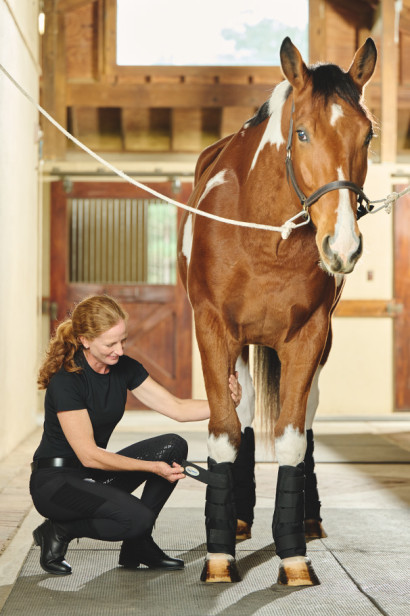Equine Therapy: Exactly How It Assists Build Confidence and Psychological Stamina
How Laser Therapy in Equine Therapy Is Changing Veterinary Treatment for Equines
Laser therapy has actually become a transformative method in equine vet treatment, supplying a non-invasive solution that speeds up recovery and improves overall wellness. Leveraging specific light wavelengths, this innovative treatment boosts mobile regrowth, lowers swelling, and minimizes pain. Its efficiency prolongs from musculoskeletal injuries to persistent conditions like osteoarthritis, significantly boosting movement and life top quality for equines. The portability and adaptability of laser therapy tools even more emphasize their growing necessity among veterinarians. As we discover the elaborate technicians and real-world successes, the profound influence on equine medical methods comes to be increasingly evident.
Understanding Laser Treatment

The innovation behind laser treatment is grounded in the principle of photochemistry, where photons are absorbed by chromophores within cells, resulting in enhanced ATP manufacturing and inflection of reactive oxygen varieties (Equine Therapy). This, consequently, advertises mobile expansion, minimizes swelling, and accelerates healing. Veterinary professionals use different sorts of lasers, including low-level lasers (LLLT) and high-power Class IV lasers, depending upon the particular restorative goals and the nature of the equine condition being treated
Various laser wavelengths and power setups are very carefully chosen to target different cells depths and accomplish wanted professional outcomes. Safety protocols are paramount, as inappropriate use can cause thermal damage or suboptimal therapeutic effects. Thus, a comprehensive understanding of laser treatment's systems and applications is critical for its efficient application in equine veterinary practice.
Advantages for Equine Health
The myriad benefits of laser treatment for equine health incorporate improved recovery, pain decrease, and improved flexibility. This sophisticated therapy modality leverages specific wavelengths of light to permeate cells, stimulating mobile feature and promoting quick tissue fixing. The non-invasive nature of laser therapy makes sure minimal tension and pain for the horse, assisting in a smoother recovery procedure.
Improved healing is one of the primary benefits, as laser treatment accelerates cellular regeneration and collagen synthesis. Pain reduction is accomplished with the anti-inflammatory results of laser treatment, which lowers swelling and reduces the production of pain-inducing chemicals.
Enhanced flexibility is an additional crucial benefit, specifically for efficiency and functioning steeds. By lowering swelling and discomfort, and boosting cells repair service, laser treatment aids in recovering joint function and muscle mass versatility. The collective effect of these benefits is not only a quicker return to typical task yet also a general improvement in the horse's lifestyle. Thus, laser treatment stands as a transformative device in modern-day equine veterinary treatment.
Common Problems Dealt With
Laser therapy has arised as a flexible therapy alternative for a selection of usual equine problems. Among these, bone and joint injuries are especially amenable to laser Bonuses treatment. Equine Therapy. Soft tissue injuries, such as tendonitis and ligament stress, benefit from the anti-inflammatory and analgesic impacts of laser therapies, which accelerate recovery and reduce pain. Additionally, laser treatment is effective for conditions like osteo arthritis, where it helps mitigate joint inflammation and advertise cells fixing.
Wound administration is another area where laser treatment has shown substantial guarantee. Chronic wounds or slow-healing ulcers can be especially difficult in horses, but laser treatment enhances cellular regrowth and boosts blood circulation, therefore expediting the healing process. Laser treatments have been effectively utilized in managing unguis conditions such as laminitis and abscesses, minimizing discomfort and advertising much faster recovery.

Modern Technology Behind Laser Treatment
Past the myriad problems treatable with laser therapy, the technology itself values better assessment. At the heart of laser therapy is the use of specific wavelengths of light to penetrate tissues and evoke biological actions. These wavelengths, commonly varying from 600 to 1000 nanometers, are precisely absorbed by chromophores in the skin, muscular tissue, visit their website and various other tissues, prompting a waterfall of cellular events.
Laser tools utilized in veterinary medication frequently utilize low-level laser treatment (LLLT) or chilly laser therapy. Unlike high-powered medical lasers, these gadgets operate at reduced power degrees, enhancing therapeutic advantages while minimizing thermal damages. The energy from the laser light stimulates adenosine triphosphate (ATP) manufacturing, enhances mobile metabolic process, and accelerates tissue repair procedures.

Success Stories and Situation Research Studies

Showcasing the concrete advantages of laser treatment, many success tales and instance researches brighten its transformative influence on equine health and wellness. One such instance includes a pure-blooded racehorse struggling with persistent tendonitis. Traditional therapies yielded very little enhancement, but after integrating laser treatment right into the routine, the equine showed significant reductions in swelling and discomfort within weeks, inevitably returning to affordable racing.
Another engaging instance features a dressage horse diagnosed with severe neck and back pain, restricting its performance. A veterinary team utilized low-level laser therapy (LLLT) to target the inflamed locations, causing significant enhancement in flexibility and a significant reduction in discomfort. Over numerous sessions, the steed restored its peak form, showcasing the efficacy of laser treatment in addressing musculoskeletal issues.
Additionally, a research carried out at a leading equine center analyzed 50 horses with numerous soft tissue injuries treated with laser therapy. The results stood out: 85% of the equines demonstrated increased healing times and improved mobility. These instances highlight the versatility and performance of laser therapy in equine medication, supplying a non-invasive, scientifically-backed method to boosting recuperation check my reference and performance in equines.
Conclusion
Laser treatment is transforming equine vet care by providing a non-invasive treatment that speeds up healing, lowers inflammation, and reduces pain. With its effectiveness in dealing with a range of problems, from musculoskeletal injuries to chronic disorders like osteoarthritis, this modern technology substantially enhances equine wellness and mobility. The mobility and adaptability of laser therapy better underscore its transformative influence on vet practices, strengthening its role as an essential tool in contemporary equine medical care.